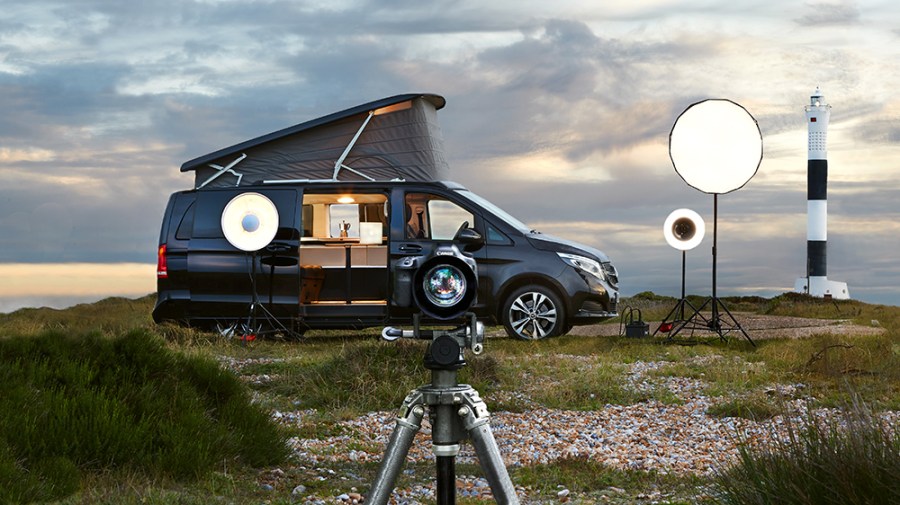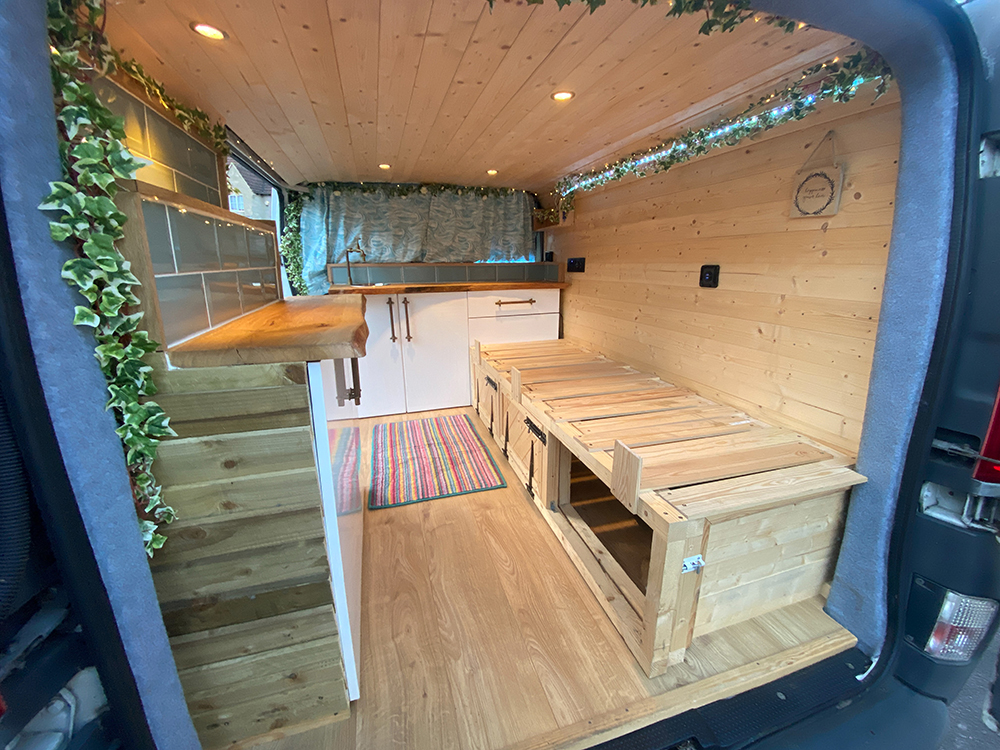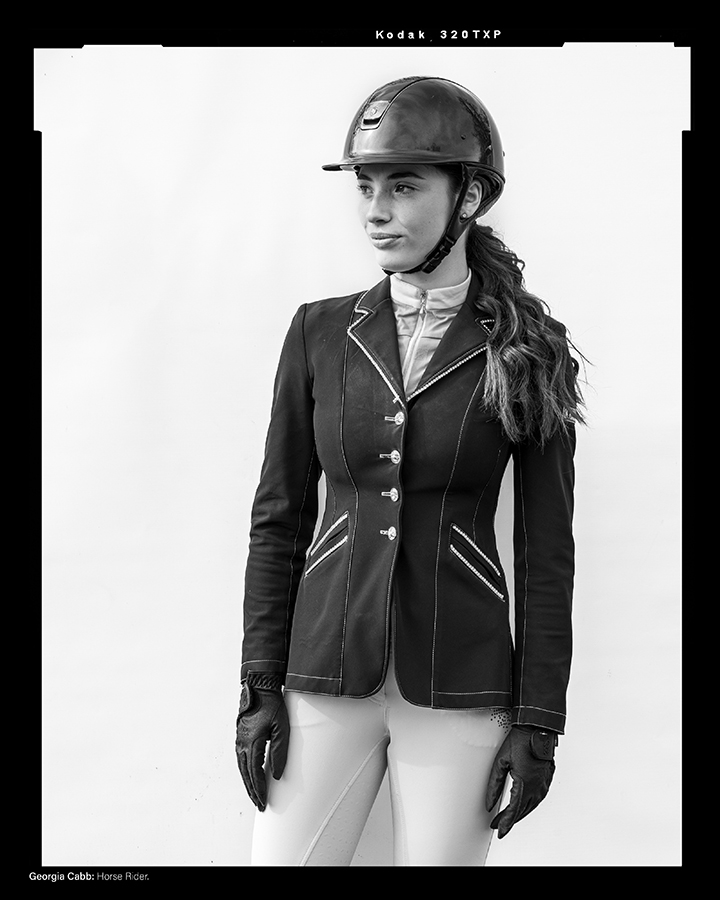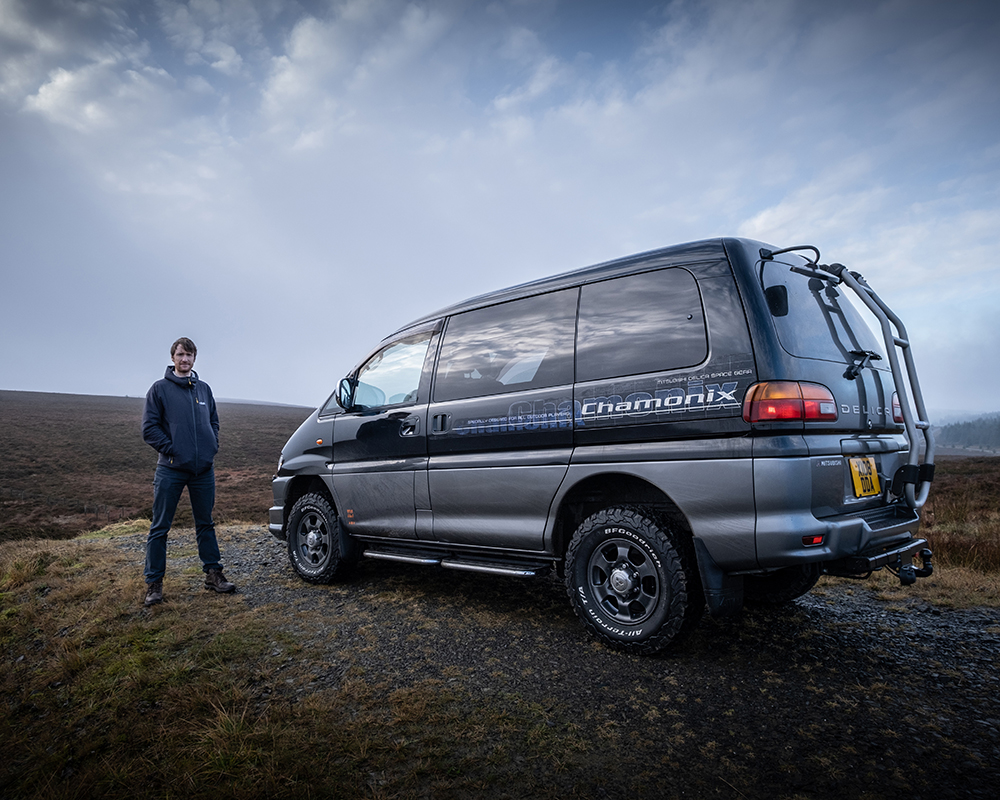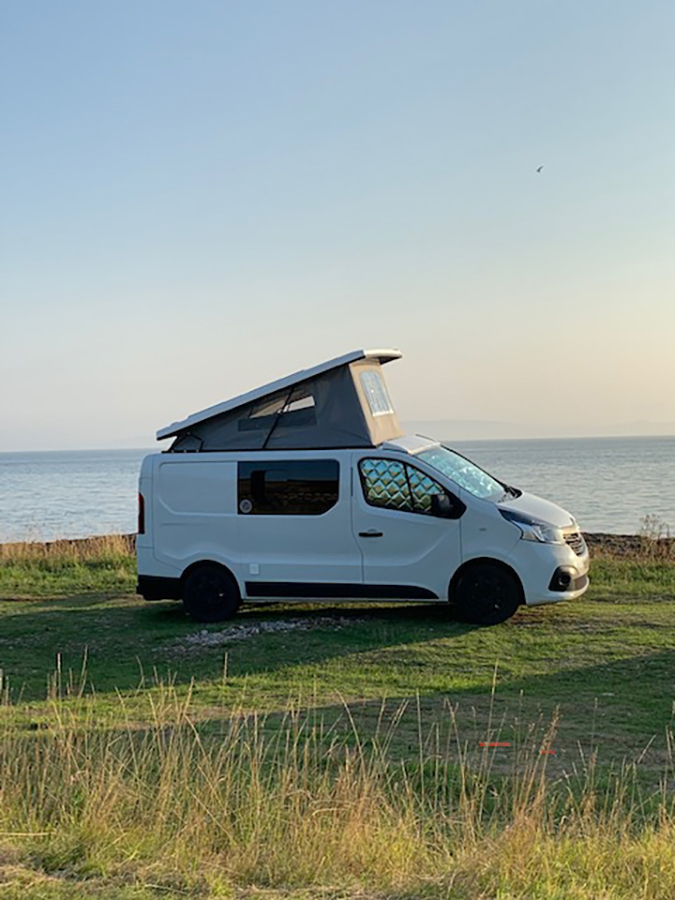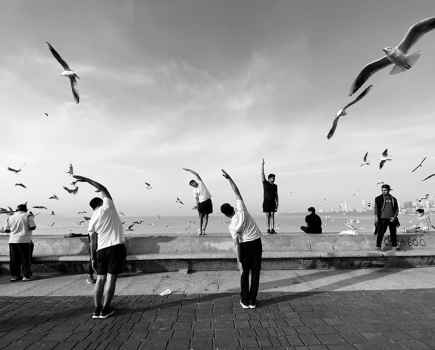After lockdown, a rumour has been building about the increase in popularity of photography vans as photographers let loose and take to the road. Peter Dench finds out more
In an unassuming Gloucestershire town, in an unassuming street, nestled among a cafe, charity shop, butcher, bank and frozen food store, a quiet revolution is taking place. Walking through the door at Clifton Cameras, you find a significant percentage of employees have taken out cash and taken up tools to purchase and convert vans to drive their adventures in photography.
‘The two biggest things in my life are photography and mountain biking. Both came to a stop during lockdown. I was furloughed, all university study was based from home. That’s where the idea blossomed. To be able to travel, ride and photograph while sticking to the Covid rules. The idea had been floating around for a while, lockdown was the ignition to get started,’ explains 23-year-old Alex McDowell, part-time sales assistant at Clifton Cameras and second-year photography student at Gloucester University.
Alex sourced a van from the several dealerships he could walk to during lockdown, eventually settling on a 2011 Peugeot Vivaro 2900. After it was stripped, cleaned, insulated, sanded, fitted with electrics, roof vent, solar panel, windows, tiles, worktop, taps, cupboard, cabinets, bed, mattress and off-road tyres – after several months of graft, Alex was ready to go and he didn’t hold back, shooting a large portion of his 17,819km British coastline project in the van.
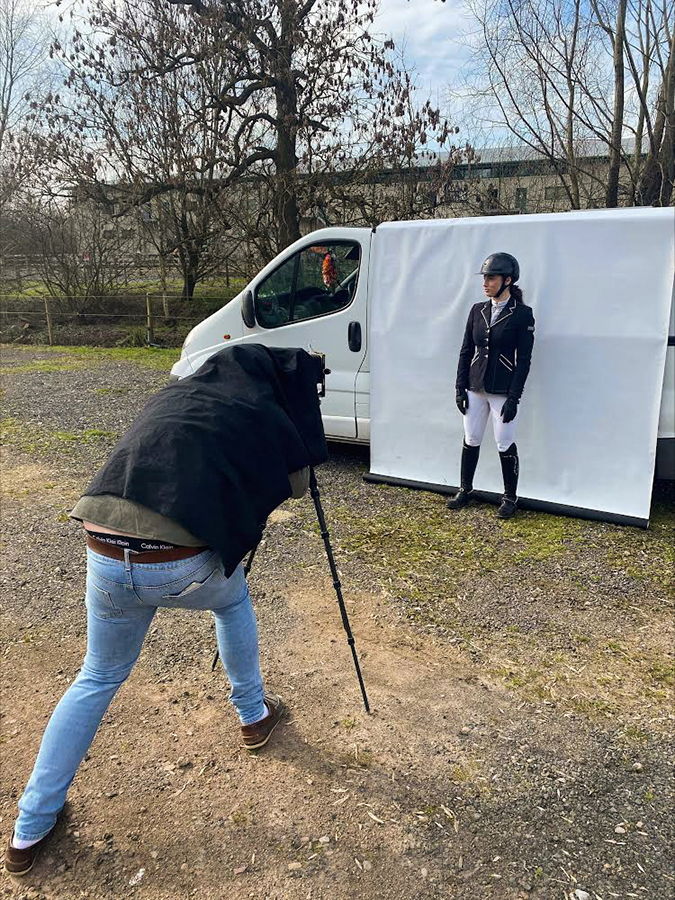
Alex McDowell uses his 2011 Peugeot Vivaro 2900 van as a pop-up studio photographing for The South West project
Despite travelling far, Alex has also been utilising the van closer to home. Inspired by Richard Avedon’s book, In the American West, he set out to document people living within a 30-mile radius – Freeminer, Field Sport Enthusiast, Allotment Owner and Horse Academy Rider. Following the Avedon pop-up studio technique, Alex hung a white backdrop from his van or nearby structure.
Using a simple Speedlite flash and softbox set-up, he captured subjects on a large-format camera using black & white film. Energised by his successes, he’s about to add to his fleet. ‘I’m going to build another van, a small darkroom that can be driven around. I do a lot of Collodion-based practice, it will open up so many opportunities.’
Walking across the wooden floor at Clifton Cameras, we meet 57-year-old buyer (and former optics specialist) Martin Drew. In the summer of 2016, on a trip to South Stack off the northwest tip of Anglesey, as hundreds of Manx shearwaters streamed past the famous lighthouse, Martin had an epiphany.
In the clifftop car park he witnessed a scene that would have life-changing consequences – a grey VW camper van: the side door was open, one occupant swivelled on the passenger seat, another lolled on the fold-down bed, the smell of coffee pervaded. ‘We’d arrived early in the morning and it was clear that the VW dwellers had overnighted there. We could only wonder at the truly spectacular sunset views these lucky people must have experienced the previous evening. We left South Stack subtly changed – for the first time in our lives, we really wanted a camper van!’ reveals Martin on the Clifton Cameras blog, www.cliftoncameras.com.
Four years rolled on and the image wouldn’t fade. Fuelled by his passion for birding and his developing interest in astrophotography, the search for the perfect family photo-van was on. ‘We had pretty much decided to go for the classic short-wheel-base (SWB), pop-top roof set-up as this would allow the van to be used as an everyday vehicle rather than just used for trips away.
We considered a number of brands – VW, Toyota, Mercedes-Benz, Ford. On Boxing Day 2020, we found ourselves 130 miles from home inspecting a recently converted SWB Renault Trafic. The van was in really nice condition (albeit in boring white) and sported a standard side conversion featuring a twin gas burner, sink and numerous cubby holes for storage.
A rock & roll double bed provided sleeping space for two and the pop-top roof concealed an elevating bed suitable for one smallish adult – ideal for our then-15-year-old daughter, Jess.’
During family excursions, Jess began to take a lot more notice of the remote natural world that Raven (as the van was christened) was able to take them to. She photographed waterfalls and experimented with shutter speeds. Jess is now in the first year of sixth form taking photography as an option. Despite the family fondness for Raven, their wings felt clipped and have traded her in for Skye: ‘The single most important thing for us is to be able to stand up.
With Raven we had the pop-top which is great but if you’re just popping into a lay-by for a cup of tea it’s a bit of a faff. We like coastal locations and if you park somewhere and it’s windy you have to be very careful as you don’t want to buckle the struts. Being able to stand up is huge for us, we’ve gone from two metres high to 2.5 metres.’
Restocking the Olympus cameras in Clifton Cameras is 35-year-old sales assistant Craig Pitts. Travelling every year since he was 19, lockdown made Pitts stop. Going stir crazy at home, he dreamt of owning a VW Transporter T5 but his wallet said no. Undeterred, he researched online and discovered a community of individuals building stealth camper vans, vans converted to a camper or living quarters but having the look of a regular van.
Last spring, tired of sleeping in the boot of a car with his mate on photography road trips, he bought a Ford Transit Connect to convert into a stealth camper to travel around the UK pursuing his photography.
Pitts made sure a robust electrical system was built to charge all his gear and laptop. In the middle of a pandemic, he took a Welsh summer road trip adventure to Rhossili, Tenby and St Govan’s. Has the stealth van worked? ‘I don’t want to bring attention to myself where I’m staying. It just looks like a builder’s van. I’ve stealth camped in Elan Valley where they banned camper vans but if you drove past my van you wouldn’t bat an eyelid. You’d think it’s a contractor van; unless I had the door open you’d never know. I’ve not had a bang on the door yet but I kind of want to tick that off!’
History of photography vans
Converting vans and vehicles for the purposes of photography is not new. In the mid-1800s, Roger Fenton captured the lives of soldiers in Crimea from his mobile, horse-drawn studio and darkroom, reportedly converted from a wine merchant’s van. More recently, between 1992 and 1996, Magnum Agency photographer Mark Power drove around the British coast in a VW camper van photographing the 31 areas for his book, The Shipping Forecast.
Photographer Simon Roberts wouldn’t be without a van. Photographing his We English project, an investigation of the English at leisure shot between 2007-2008, Roberts utilised a 1997 Express Talbot Swift Capri for his extended journeys across the UK. To capture people situated in the landscape, he often photographed from on top of the Capri.
In 2013 I turned on the sat nav and slid alongside photographer Anastasia Taylor-Lind in the front of her 2006 Peugeot van as she set off across Europe on her Negative Zero project about fertility rates and population decline. Purchased for £5k, the van with extra costs and insurance took the total to nearer to £7k.
For her odyssey, she had stocked the van with a coat hanger, electric blanket, baby wipes, Heinz food products, Earl Grey tea, cartons of dry noodles, a fluffy rug and six books. In the hilarious 2017 television mini-series, Confessions of the Paparazzi, controversial pap George Bamby, regales mischievous tales from the back of his van containing pap-essential items – bunk bed, kettle, football and drone.
In the episode, ‘Extra, Extra: My First Time with Mary’, he attempts to frame Britain’s baking darling, Mary Berry, by papping her from a lens-sized hole cut in the side of his van. Photojournalist Tom Stoddart decided to stop travelling around in a van for his reportage, The Britons, after he went to photograph a Hull boating regatta, parked under a bridge to sleep for the night and had a rude awakening from doggers.
Versatility
Landscape photographer Thomas Heaton remembers being Wowed! looking through a magazine back in 2004-5 and coming across an article about photographing grouse in the Scottish Highlands. The photographer talked about his workflow pictured alongside an old motorhome used as a base. Fifteen years later, Heaton got his first camper van, a Ford Transit.
‘I left my job to do photography full time so it was like an investment. The problem with camper vans is people buy them then don’t use them because they don’t have the time. I’d always wanted one. Two main reasons for not having one was price and time to use it. The odd weekend in summer doesn’t really cut it. I was full time, this is it, now or never. Got the camper van and never looked back, except to park.’
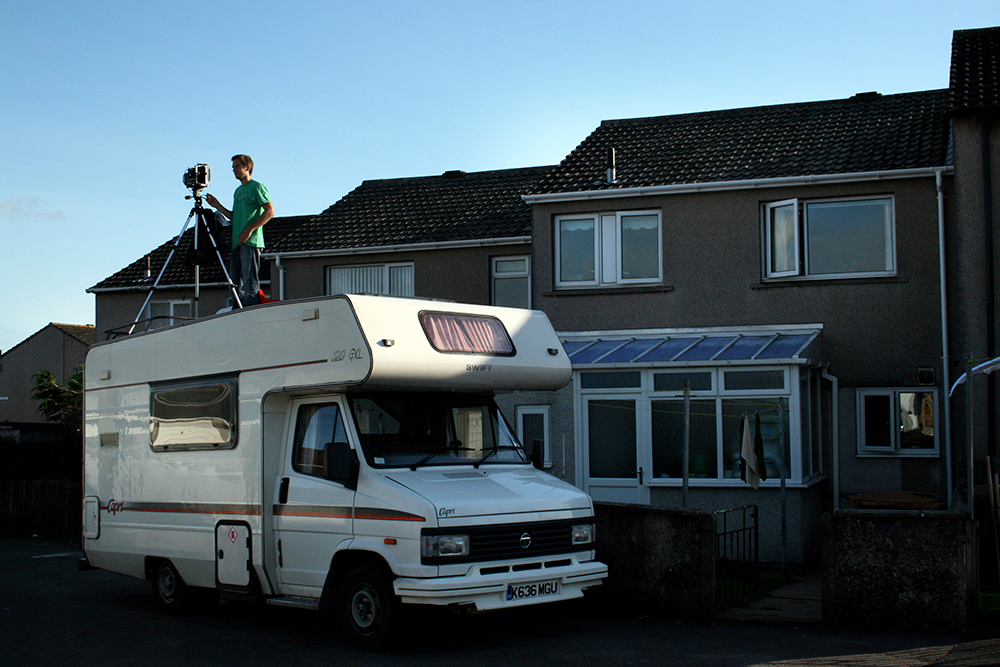
Simon Roberts photographing from the roof of his 1997 Talbot Swift Capri for his We English project ©John Roberts
Moving on from the Ford Transit, in 2021 Heaton imported a 2002 Mitsubishi Delica camper van from Japan to convert into an off-grid, off-road, go-anywhere 4×4 camper van. He’s cleverly incorporated the van into the storytelling of his landscape photography, making it part of the bigger picture. His YouTube channel has over 508k subscribers.
A new video is posted every Wednesday, many featuring the van. The first of a four-parter documenting his Mitsubishi received over 973,000 views. ‘For a photographer, especially a landscape or wildlife photographer or any photographer who needs to be outdoors, a van is as important as a lens, or tripod, it opens up the landscape.
I can’t believe I used to sleep in my car, pay for expensive hotel rooms or camp in a tent – which is great but not practical if it’s bad weather. Having a vehicle to sleep in, back up and edit images, check all’s well is huge. The van encourages me to go out more, see more places and be a lot more versatile. I can check the weather before deciding if I set off north or south. If you don’t have that luxury of versatility and you’ve pre-booked a hotel or caravan then you’re kind of stuck with what you’re given.’

Andy Earl drove his Mercedes Benz Marco Polo to Holland to photograph band Birmingham Electric at Radio Kootwijk
On a recent warm and welcoming early spring afternoon, I stroll into the Vinyl Cafe in north London to meet legendary photographer Andy Earl. It’s a fitting place to meet the man who’s shot over 120 covers and iconic album sleeves for Pink Floyd, Duran Duran, Cranberries and Bow Wow Wow among others. Earl’s decision to adopt a photo-van also rose out of lockdown.
He sold his elderly Range Rover and in July 2020 invested in a Mercedes Benz Marco Polo. ‘Covid hit big time so I thought it would be great if I could go along and do photo-sessions and turn up and be completely independent – sleep in it, eat in it, do everything and not be infectious or infected. That worked quite well but people were still cautious, preferring I set the camera up and walk 2 metres away to take the shot. There was so much nervousness,’ he says, stirring a flat white.
Earl opted for the first-class experience, the Mercedes equipped with Wi-Fi, sink, double cooker, fridge, loo, cold shower, air conditioning, night heater and bed with sprung mattress. You could put the roof up, rearrange the seats, sit comfortably and work in style. The van could be adapted to host talent in an on-board green room and make-up area.
In the end it proved too high-end. ‘It was so smart you had to keep it clean the whole time. If I’d have got something and converted it, that might have been better. I got a bespoke piece with all the trimmings and that’s what I was attracted to. I was swayed by the comfort, it was lovely to drive, economical. All those were good but that was my only everyday car. That was the problem – running down to the shops to get a paper you didn’t want to jump in the van.’
Earl’s long-term dream was to echo Irving Penn’s Worlds in a Small Room, travelling to meet people and communities to photograph against a heavy plain canvas. ‘Every time I put a sheet up the bloody thing blew away.’ After just under two years, Earl’s adventures in vanning are over.
He cashed out and cashed in getting back what he paid for it. ‘It was great when I used the van and great for that time. I enjoyed it. I’ve never done camper vanning before. It got a massive response from everybody wanting to do shoots and then when it came to it they didn’t need the van. I wasn’t using it as a way of earning money by hiring it out – if you wanted me, the van came too.’ This modernist of photography is now contemplating a SUV size Tesla Model X.
A van may not directly improve your photography skills but will give you more opportunities and freedom to learn. It’s hard work but can be tremendous fun. At the end of another busy trading day at Clifton Cameras, 23-year-old new recruit Megan Bendall joins Martin, Alex and Craig sitting around a white table. The conversation turns to plans for the weekend. “I might take a trip out in my converted 2014 Ford Transit Minibus photo-van,’ she says.
Safe travels.

Inside Earl’s Mercedes, a flexible digital photo studio that enabled him to travel to shoot locations both on and off grid
Top ten photography van tips
- Do your research. Don’t buy the first van you see on the market. You might not enjoy it, it’s not always luxurious and can be quite miserable at times, it’s cramped. Maybe hire one, see if you enjoy it.
- Don’t just buy the cheapest van, as it may end up costing you more long term. If able, take someone along who knows what they’re doing.
- Create a 3D model of your van layout. Tinkercad is web-based, free and easy to use.
- Fundamentally you need three things: somewhere comfortable to sleep (a van with a mattress in would do the job); somewhere to make a cup of tea; and somewhere to store your camera gear.
- According to Comfort Insurance, there are no UK laws stopping you from living in your motorhome, camper van or van full-time. The only requirement is the vehicle has passed its MOT and is road legal.
- There may be restrictions on where you can park up and reside, which you’ll need to research yourself depending on where you decide to go. Being able to take your home with you doesn’t mean you can park anywhere any way you like. Try an app like Park For Night and consult The Highway Code.
- Watch a bunch of van build YouTube videos. They give you an idea of what you want your van to look like. How you want it to function. Think about the purpose of your van. Is it something you’ll be living in full-time or just use at weekends or week-long photo-trips?
- Test different vans, as some of the smaller ones are just no good. The short-wheeled versions are more stealthy but may not be practical. The size of the van dictates the layout of the van.
- Consider adding some big off-road tyres so you can park on a grass verge or more rugged terrain.
- The van community is generally friendly but proceed with caution, be careful who you talk to. Don’t draw attention to the fact it’s a photo-van with thousands of pounds of gear inside. It might not be there when you pop back from the loo.
Further reading:
Is it a bird or is it a plane? Capturing Dod Miller’s Birdmen
How to take stunning starry night scenes this summer
How photography boosts your mental health: real-life stories

